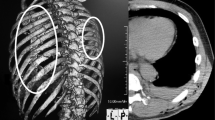Abstract
We describe computed tomographic (CT) findings in two patients with cardiac injury who required emergency surgery. Chest CT revealed an unexpected low-density area, indicating pericardial effusion. We emphasize that, given the situation of trauma, an incidental low-density area covering more than two slices along the inferior border of the heart suggests pericardial effusion, which may be caused by cardiac injury.
Similar content being viewed by others
References
Kulshrestha P, Das B, Iyer KS, Sampath KA, Sharma ML, Rao IM, et. al. Cardiac injuries: a clinical and autopsy profile. J Trauma 1990;30:203–7
Symbas PN. Cardiac trauma. Am Heart J 1976;92:387–396.
Brathwaite CEM, Rodriguez A, Turney SZ, Dunham CM, Cowley RA. Blunt traumatic cardiac rupture: 5-year experience. Ann Surg 1990;212:701–704.
Williams JB, Silver DG, Laws HL. Successful management of heart rupture from blunt trauma. J Trauma 1981;21:534–537.
Sugg WL, Rea WJ, Ecker RR, Webb WR, Rose EF, Shaw RR. Penetrating wounds of the heart: an analysis of 459 cases. J Thorac Cardiovasc Surg 1968;56:531–545.
Marshall WG Jr, Bell JL, Kouchoukos NT. Penetrating cardiac trauma. J Trauma 1984;24:147–149.
Beall AC Jr, Patric TA, Okies JE, Bricker DL, DeBakey ME. Penetrating wounds of the heart changing patterns of surgical management. J Trauma 1972;12:468–473
Leavitt BJ, Meyer JA, Morton JR, Clark DE, Herbert WE, Hiebert CA. Survival following non-penetrating traumatic ruprure of cardiac chambers. Ann Thorac Surg 1987;44:532–535.
Reif J, Justice JL, Olsen WR, Prager RL. Selective monitoring of patients with suspected blunt cardiac injury. Ann Thorac Surg 1990;50:530–533.
Jimenez E, Martin M, Krukenkamp I, Barrett J. Subxiphoid pericardiotomy versus echocardiography: a prospective evaluation of the diagnosis of occult penetrating cardiac injury. Surgery 1990; 108:676–680
Frazee RC, Mucha P Jr, Farnell MB, Miller FA Jr. Objective evaluation of blunt cardiac trauma. J Trauma 1986;26:510–520.
Mattox KL, Limacher MC, Feliciano DV, Colosimo L, O'Meara ME, Beall AC, et al. Cardiac evaluation following heart injury. J Trauma 1985;25:758–765.
Fonner BT, Vogelzang RL. Right atrial rupture due to blunt trauma: CT evaluation. Comput Med Imaging Graph 1992;16: 27–29.
Frantz KM, Fishman, EK. Hemopericardium leading to cardiac tamponade in the traumatized pediatric patient: discovery by CT. Clin Imaging 1992;16:180–182.
Goldstein L, Mirvis SE, Kostrubiak IS, Turney SZ. CT diagnosis of acute pericardial tamponade after blunt chest trauma. AJR Am J Roentgenol 1989;152:739–741.
Pillgram-Larsen J, Løvstakken K, Hafsahl G, Solheim K. Initial axial computerized tomography examination in chest injuries. Injury 1993;24:182–4
Author information
Authors and Affiliations
Rights and permissions
About this article
Cite this article
Shimoyamada, K., Yamaguchi, T., Hayakawa, M. et al. Significance of incidental pericardial effusion on computed tomography in cardiac trauma: A report of two cases. Emergency Radiology 3, 130–133 (1996). https://doi.org/10.1007/BF02440033
Issue Date:
DOI: https://doi.org/10.1007/BF02440033




